In June of 2016 we did two spectacular back-to-back tours where we took our guests on a sprawling exploration of Northern Spain. The tours began from our lush, tropical Catalonian Villa just outside the incredible gem that is Sitges (aka the Saint-Tropez of Spain). Sitges is a picturesque village along the coast of Catalan where, during the summer months, this little town becomes an oasis for gay men (and a handful of lesbians) from around the world. It’s literally the only time we’ve stayed in a place where we were the majority of the city’s population!
On our first night of the tour, we took our guests out on the town for a fabulous drag show starring the legendary Spanish drag queen Sharonne (the winner of RuPaul’s Drag Race España Season 2). We met her after her first set and I ended up joining her on stage afterwards to sing a duet of “Proud Mary” by Tina Turner! The next day we had an absolutely revelatory visit to the Cau Ferrat, the home-turned-museum of Santiago Rusiñol, father of the Modernisme movement in Catalan and one of the greatest painters and writers of his time. [Check out my full-length article about his work and life here!]
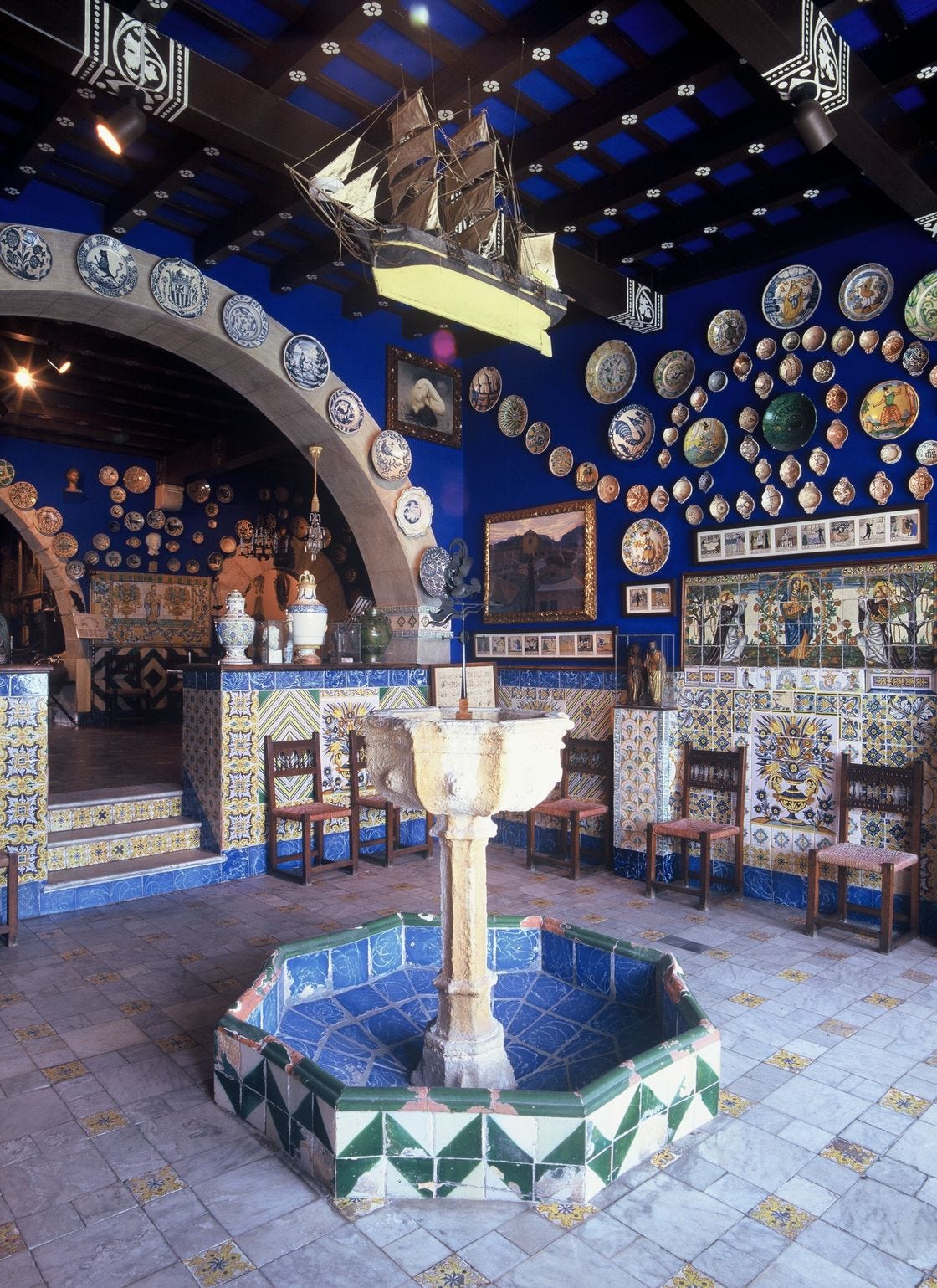
On a day trip to Barcelona, just 35 kilometers north of Sitges, we toured the Joan Miró and Picasso museums and had an unforgettable 14-course tasting menu at Carme Ruscalleda’s flagship 3-Star Michelin restaurant Sant Pau on the Costa Brava (probably one of the finest dinners we’ve EVER had).
Then we made our way to Zaragoza, a city that appears to be frozen in time… that time being the Spanish Inquisition. At the Cathedral-Basilica of Our Lady of the Pillar we encountered a group of overly zealous señoras, clad head-to-foot in black, on their knees, flagellating themselves and tossing their meager earnings into a collection box beneath a very dubious relic. Fortunately, our redemption came by way of a tour of the incredible Goya Museum followed by lunch at the phenomenal Los Victorinos, Zaragoza’s number one tapas bar. We devoured croquettes stuffed with seafood and artichoke, grilled boletus mushrooms with shaved black truffles, beautifully aged slices of Iberico ham and salt cod brandade smeared over fried bread, all washed down with some perfectly chilled bottles of macabeo.
As we spiraled along the beautiful winding roads of the Basque country, we descended into San Sebastián, an absolute jewel of a city. We did wine tastings at some of the greatest wineries in La Rioja (Bodegas Muga, La Rioja Alta and Bodegas López de Heredia) and spent a memorable afternoon at the Guggenheim Museum in Bilbao. We ate pintxos at the most extraordinary pintxo bars in San Sebastián, as well as a 10-course dinner at Arzak, the inimitable institution of world-renowned chef Juan Mari Arzak and his daughter Elena.
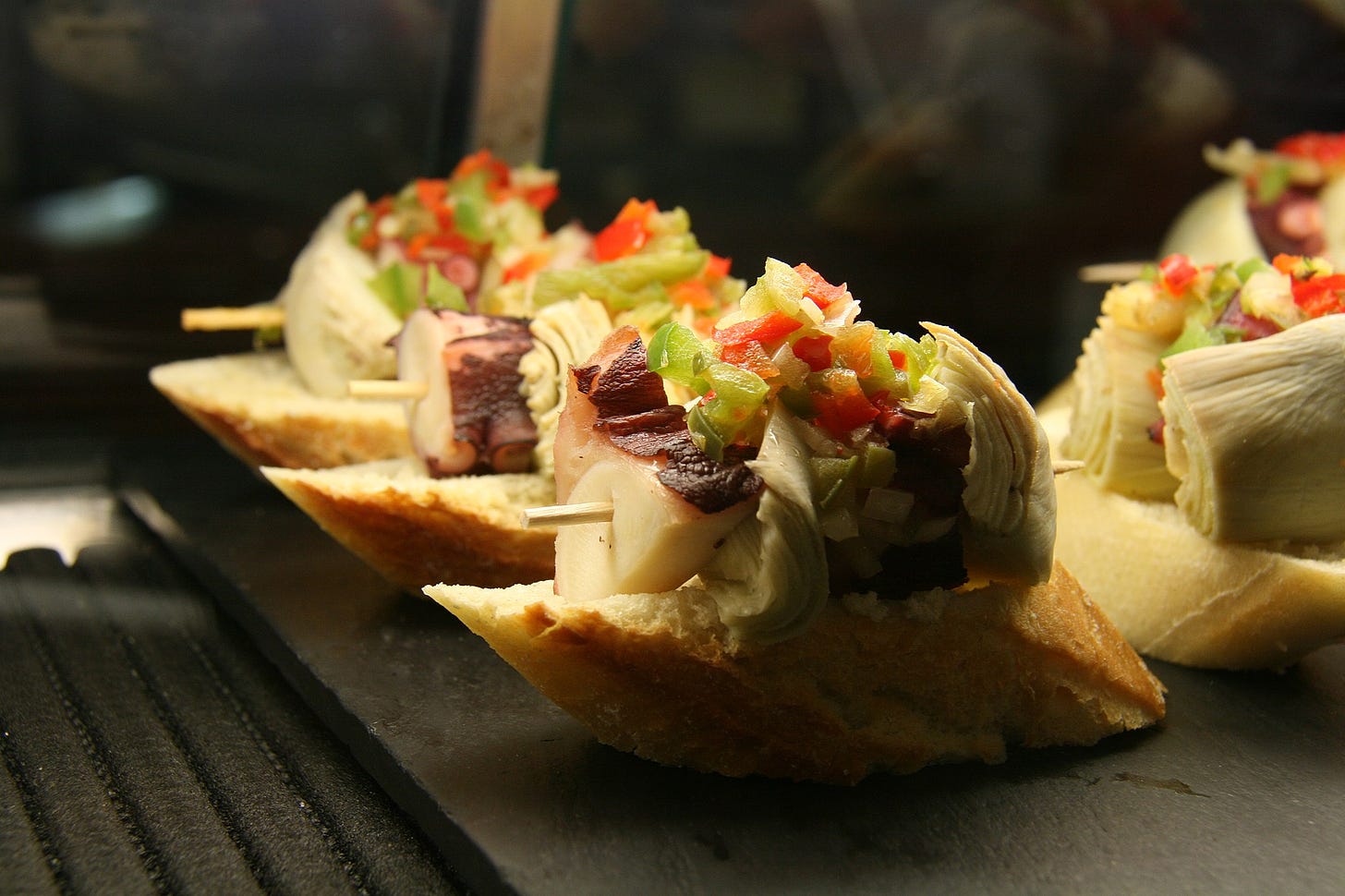
It was one of our most successful tours, but after 20 days of hosting two tour groups of nine people each from 8am to midnight every day, we were completely knackered. Our spring tour season was finally over and we were preparing to head back to Paris for a few days before flying home to collapse in our little cabin in the woods. By chance, we found a flight from San Sebastián to Paris with a 24-hour layover in Madrid, a city we’d never visited. We were instantly excited at the thought of being able to go out to dinner and spend even half a day exploring the Museo del Prado. Then, to our even greater delight, we noticed that the Prado just happened to be presenting an exhibition marking the fifth centenary of the death of Hieronymus Bosch, an artist whom we both absolutely worship.
The museum website boasted that this was “an unrepeatable opportunity to see a remarkable group of works comprising the eight original paintings by the artist to be found in Spain together with others loaned from collections and museums around the world. This represents the greatest number of Bosch’s works ever to be assembled, created by one of the most enigmatic and influential artists of the Renaissance.” This was a once-in-a-lifetime event. We both gasped with joy and booked our flight immediately!
The next day, we took the quick flight from San Sebastián to Madrid and checked into our cozy apartment around the corner from the Prado Museum. Despite the fact that we had high hopes for a spectacular dinner at some amazing restaurant in Madrid on our first and only night there, we were almost entirely out of money and completely exhausted from our tours. So we ended up buying a baguette from a nearby bakery and headed back to our apartment to make sandwiches with the leftover cheese and charcuterie we’d brought on the plane with us from our last tour. We did, however, enjoy our sandwiches with a bottle of 1985 La Rioja Alta S.A. Gran Reserva Rioja (a classic vintage one of our guests gifted us) and then off to bed we went.
Our flight the next day to Paris was at 5pm, so we only had a limited amount of time to see the Prado. We got up early and headed out for a quick breakfast of some café con leche and delectably warm magdelenas and arrived at the museum just before it opened. There were so many artists we wanted to see but, due to our time constraints, we chose to make Bosch our priority. It was mid-June and the exhibition had just opened two weeks prior, so the museum was understandably crowded. The rooms, however, had been so beautifully and strategically curated by Pilar Silva Maroto, the head of the Department of Conservation of Flemish Painting and the Northern Schools up to 1700, that the crowd didn’t matter. Due to the nature of Bosch’s many triptychs, Dr. Maroto had placed all of the artist’s most famous paintings in the center of each room so that visitors could have a 360-degree view of each piece. Not only did this facilitate an incredible opportunity to see the works up close, it eliminated the kind of tedious and unwarranted crowding that occurs around works like the Mona Lisa at Le Louvre.
We have visited museums in every city that we have ever passed through, even if it’s just a small local archeological museum. It’s one of our passions. But I’m not sure if any exhibition has triggered such a profound response of aesthetic arrest in either of us as the quincentenary exhibition of Hieronymus Bosch at the Museo del Prado in Madrid.
Standing in front of The Garden of Earthly Delights, its sheer splendor was almost more than I could take. Although I’ve admired this work for over 30 years, I wasn’t prepared for the magnitude of it in person. The scope of Bosch’s genius for detail and his ability to set one’s perspective awhirl can completely overwhelm the senses when trying to take in a small section of the work, let alone its entirety. Without warning, the feeling of aesthetic arrest, something that people describe occurring to them before great works of art, happened to me for the first time. Tears began to stream down my face at the pure magnificence of the images before me. [Much like my reaction to the Dead Can Dance concert we recently described in our last article, Aesthetic Arrest 5/27/22. Dead Can Dance, coincidentally, used the small detail of the man and woman in a sphere from The Garden of Earthly Delights as the cover of their fifth album, Aion (one of my favorites).]
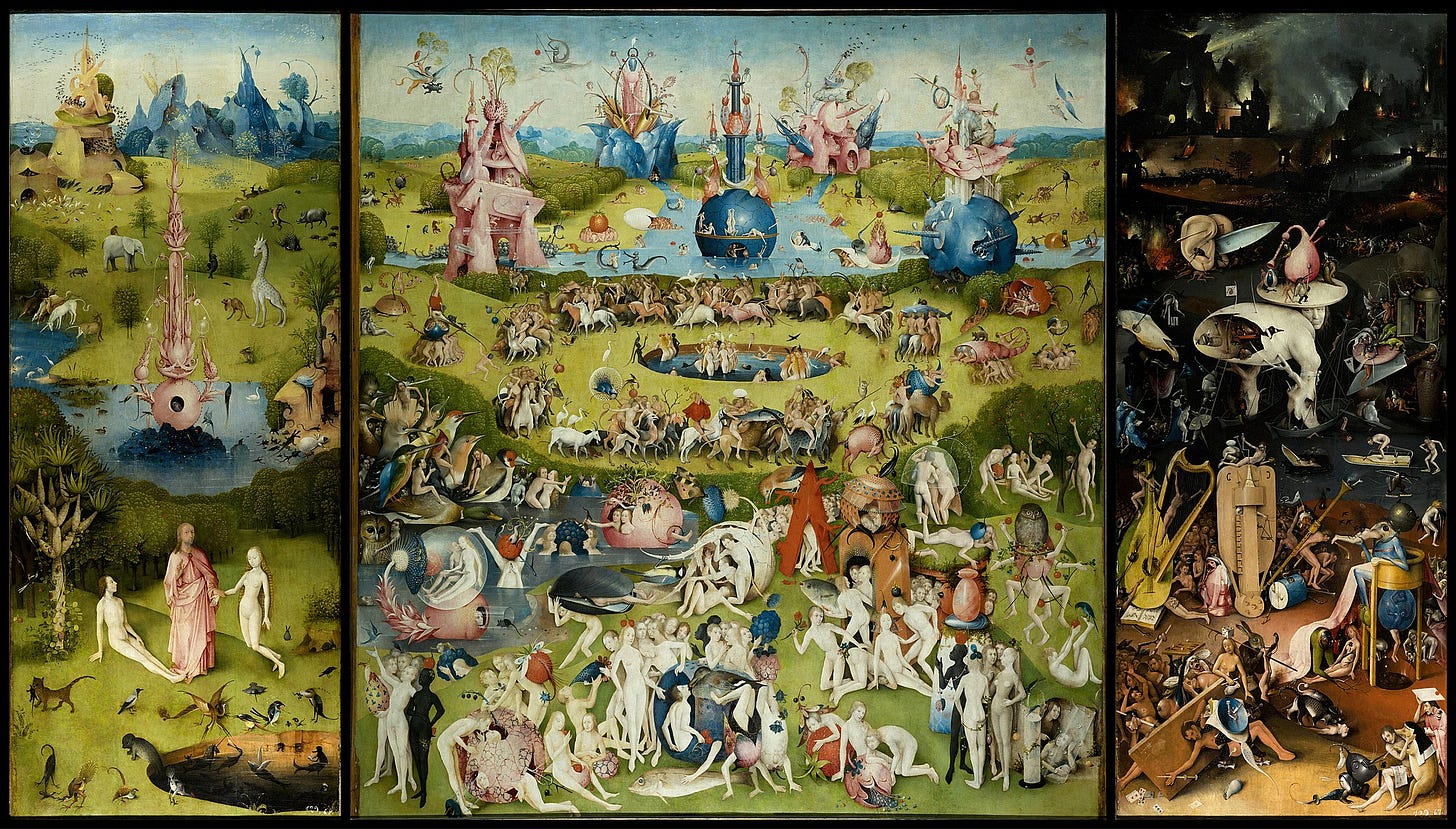
Similarly, the Triptych of the Temptation of St. Anthony rendered me absolutely awe-struck at the intricate surrealist landscape, a vision unsurpassed by artists before or since. I spent a good 25 minutes standing in front of the painting, my eyes scouring every mind-blowing brushstroke of flying fish, hybrid bird creatures tumbling out of fruit houses, opossum-headed clergymen and rats carrying gaunt, tree-faced, armadillo-tailed mothers.
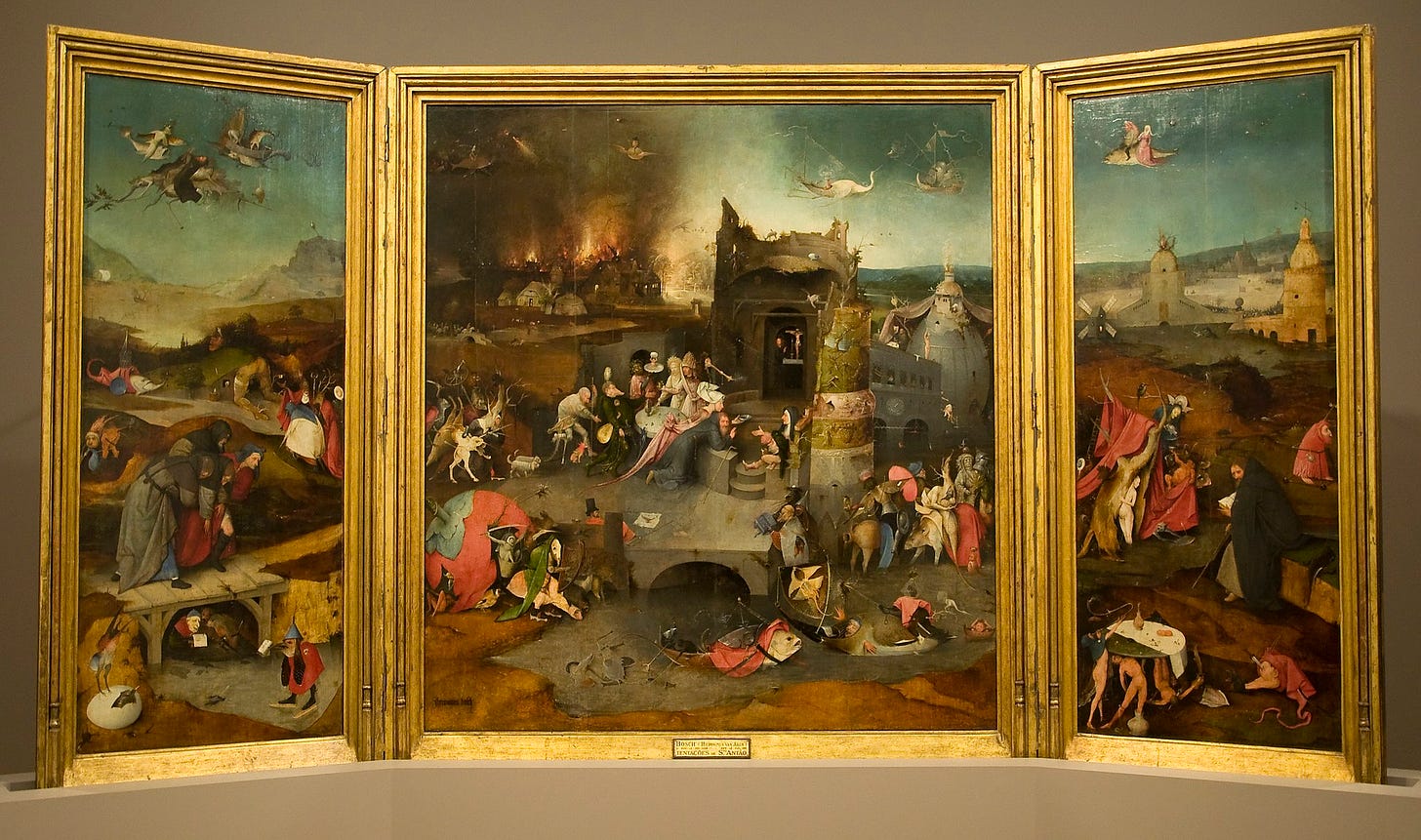
And then there’s the enigmatic The Haywain Triptych. Many have speculated on the religious nature of Bosch’s paintings but none of their theories adequately explain his entirely unorthodox and unearthly depictions of creatures beyond the realm of Christianity or any other religion. In the left panel of The Haywain, for example, there’s a more than slightly heretical element to his interpretation of God giving the Garden of Eden to Eve whilst swarms of menacing, wingèd insect-like creatures tumble from the heavens to land and sea, intimating a less than God-like origin of life on Earth (a concept solidified by Darwin some 340 years later).
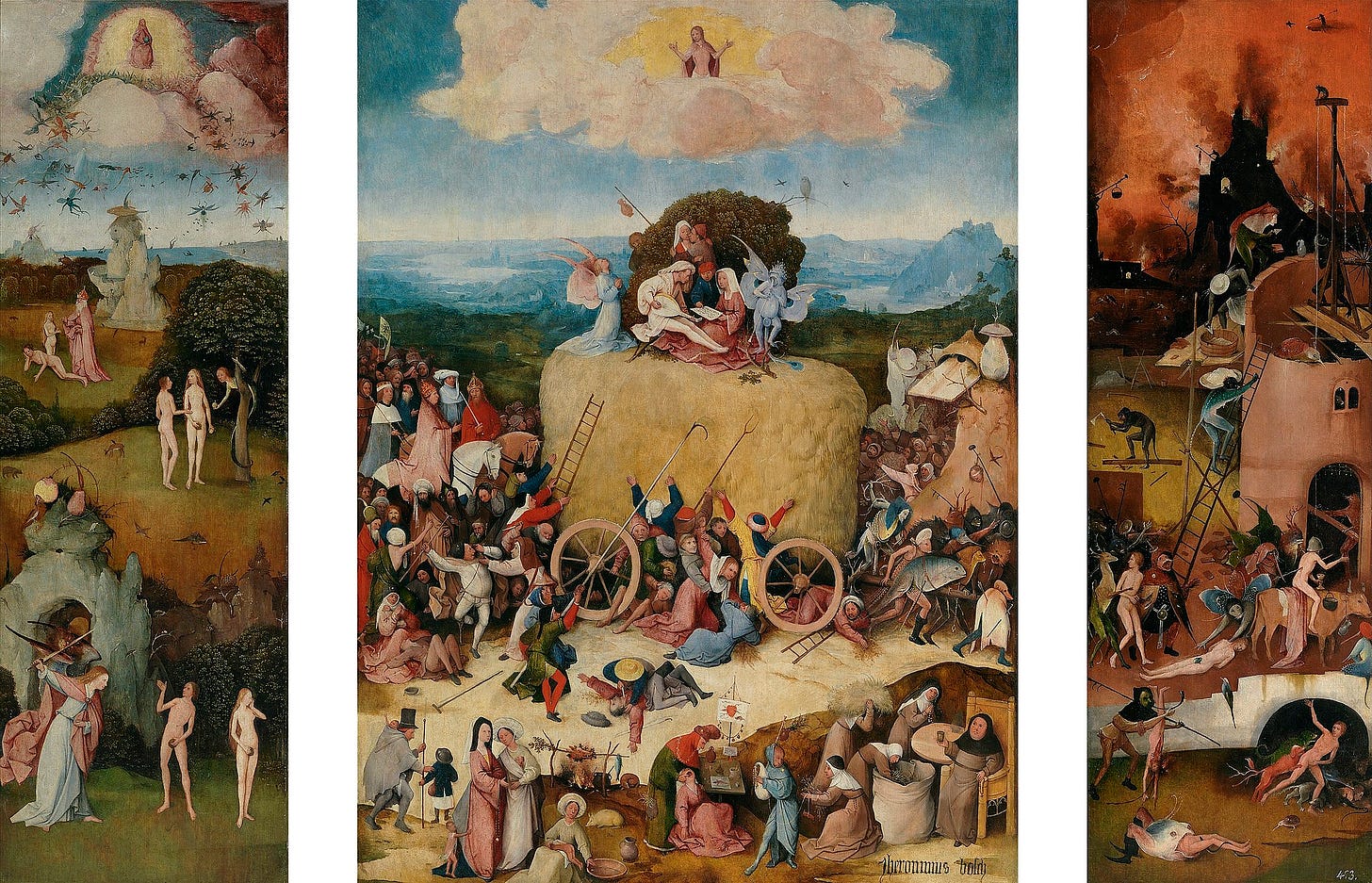
As we rounded the corner, we came upon the twisted and rather violent painting of The Last Judgment, a work so sadistic that it could double for the LeMarchand Configuration that unleashes Clive Barker’s Cenobites in Hellraiser. I don’t think the uniquely perverse aspects of the work can be overstated. To set eyes on images of small, vaguely amphibious creatures skewering naked human bodies, squatty old ghoul-faced nuns frying human heads and limbs in skillets or a bird-headed fish with feet being ridden by a mechanical, helmeted blue-faced head with no body, is simply something you don’t see much of in 15th-century paintings. It must have been shocking to viewers in the late 1400s. And I can attest, without reservation, that it is still shocking today.
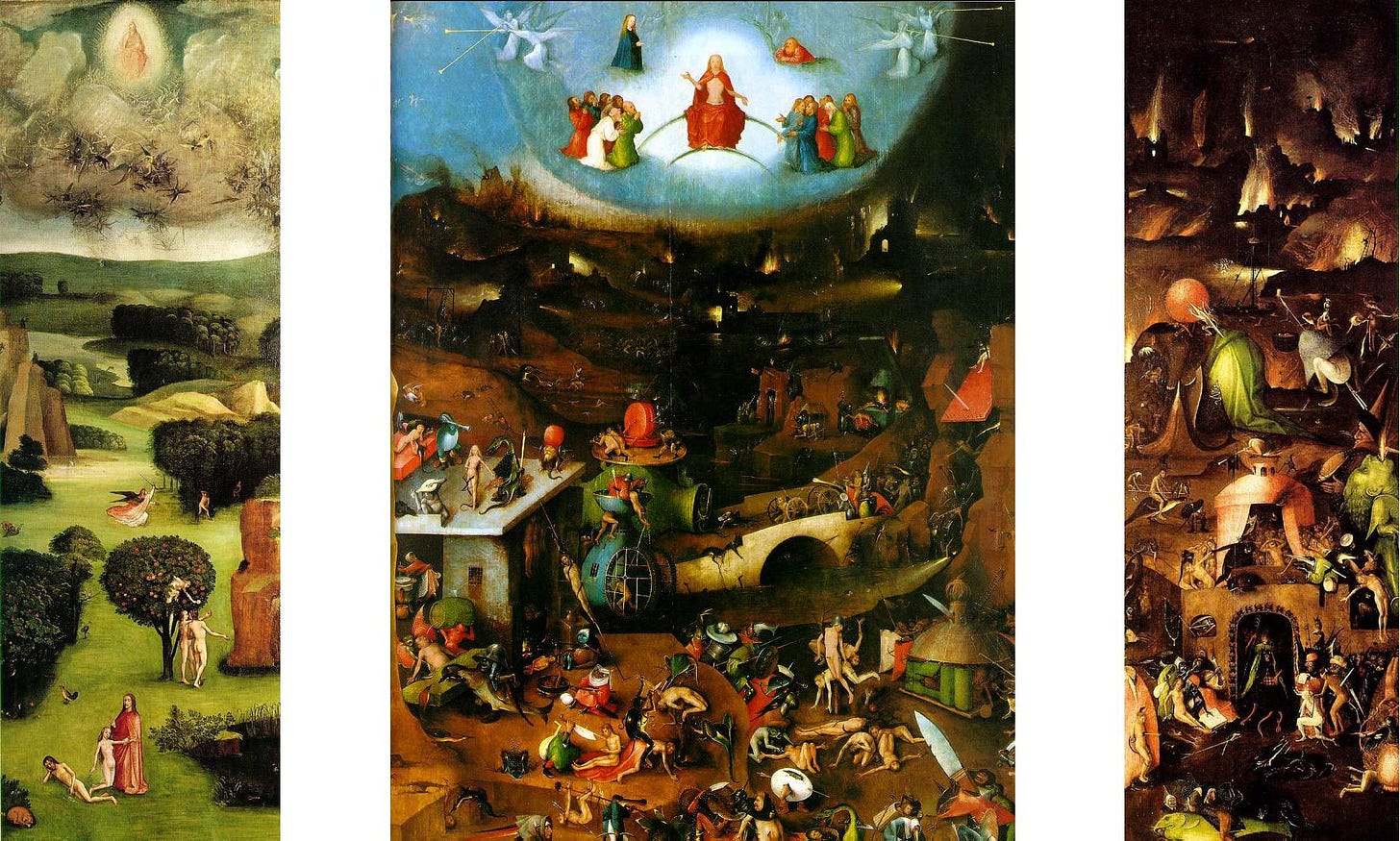
I know that I can speak for both of us when I say that having the remarkable opportunity to see the works of Hieronymus Bosch in person and to be able to spend many hours poring over every inch of each canvas was, without a doubt, an experience of unequaled aesthetic arrest that will stay with us for the rest of our lives.
But after several hours at the museum our senses were entirely overloaded. It was definitely time for a much-needed break of another café con leche and some warm churros con chocolate before going back to hit the rest of the Prado for Tiepolo, Rubens, Velázquez, Titian, Raphael, Goya and El Greco!




Seeing a great work of art in person can be such an emotional experience. The first time I saw a Vermeer in person at the Rikesmuseum in Amsterdam (albeit a bit gentler work than Bosch's works), I had that same "Aesthetic Arrest" and found myself drowning in tears.